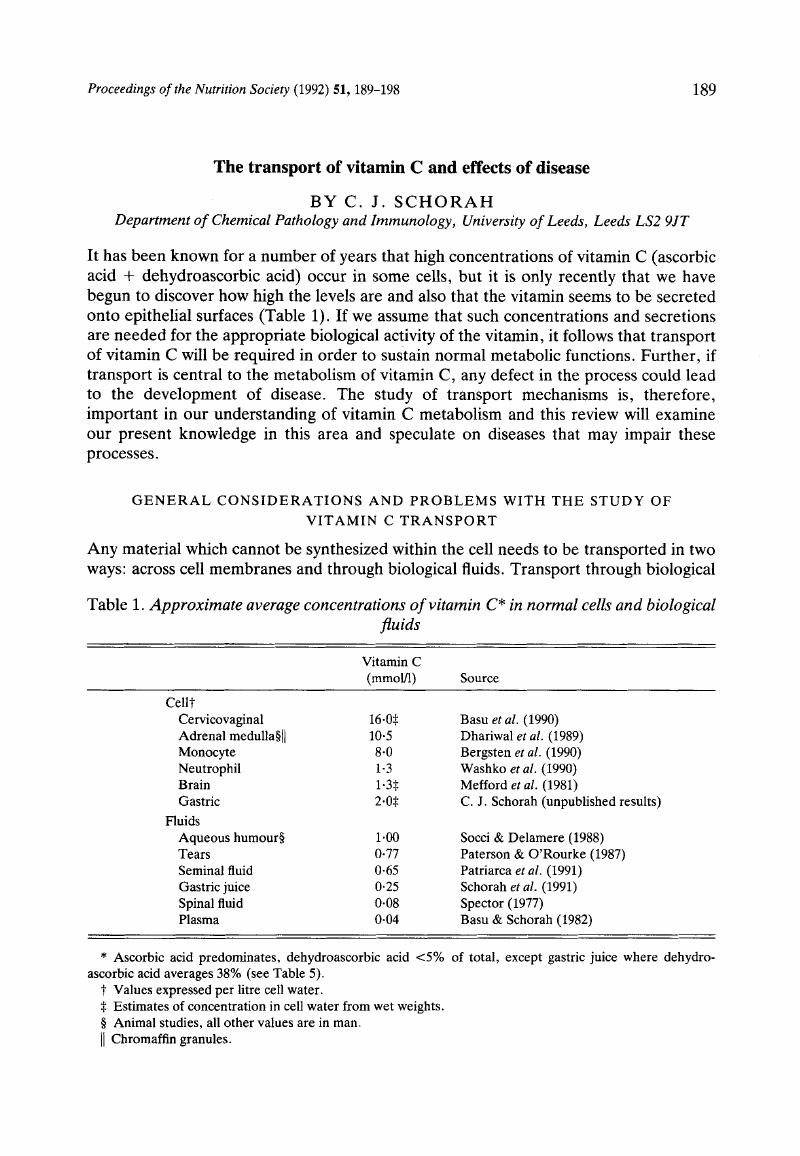Crossref Citations
This article has been cited by the following publications. This list is generated based on data provided by Crossref.
Bates, C. J.
and
Heseker, H.
1994.
Human Bioavailability of Vitamins.
Nutrition Research Reviews,
Vol. 7,
Issue. 1,
p.
93.
Schorah, Christopher J
1995.
How I found myself in nutrition.
Nutrition Bulletin,
Vol. 20,
Issue. 1,
p.
48.
McGill, E J
1995.
Lipid‐lowering dietary advice in diabetes.
Practical Diabetes International,
Vol. 12,
Issue. 4,
p.
157.
Schorah, CJ
Downing, C
Piripitsi, A
Gallivan, L
Al-Hazaa, AH
Sanderson, MJ
and
Bodenham, A
1996.
Total vitamin C, ascorbic acid, and dehydroascorbic acid concentrations in plasma of critically ill patients.
The American Journal of Clinical Nutrition,
Vol. 63,
Issue. 5,
p.
760.
Benzie, I. F. F.
1996.
Lipid peroxidation: A review of causes, consequences, measurement and dietary influences.
International Journal of Food Sciences and Nutrition,
Vol. 47,
Issue. 3,
p.
233.
Eastwood, Martin
1997.
Principles of Human Nutrition.
p.
177.
Schorah, C.J.
1997.
Vol. 57,
Issue. ,
p.
1.
Waring, Alison J
and
Schorah, Christopher J
1998.
Transport of ascorbic acid in gastric epithelial cells in vitro.
Clinica Chimica Acta,
Vol. 275,
Issue. 2,
p.
137.
Benzie, Iris F. F.
1999.
Vitamin C: prospective functional markers for defining optimal nutritional status.
Proceedings of the Nutrition Society,
Vol. 58,
Issue. 2,
p.
469.
Kendall, Martin J
and
Nuttall, Sarah L
1999.
Anti-oxidant therapy for the treatment of coronary artery disease.
Expert Opinion on Investigational Drugs,
Vol. 8,
Issue. 11,
p.
1763.
Davey, Mark W
Montagu, Marc Van
Inz�, Dirk
Sanmartin, Maite
Kanellis, Angelos
Smirnoff, Nicholas
Benzie, Iris J?J
Strain, John J
Favell, Derek
and
Fletcher, John
2000.
PlantL-ascorbic acid: chemistry, function, metabolism, bioavailability and effects of processing.
Journal of the Science of Food and Agriculture,
Vol. 80,
Issue. 7,
p.
825.
Zhang, Z. W.
and
Farthing, M. J. G.
2000.
Helicobacter pylori.
p.
513.
Eggersdorfer, Manfred
Adam, Geo
John, Michael
Hähnlein, Wolfgang
Labler, Ludvik
Baldenius, Kai-U.
von dem Bussche-Hünnefeld, Linda
Hilgemann, Eckhard
Hoppe, Peter
Stürmer, Rainer
Weber, Fritz
Rüttimann, August
Moine, Gérard
Hohmann, Hans-Peter
Kurth, Roland
Paust, Joachim
Hähnlein, Wolfgang
Pauling, Horst
Weimann, Bernd-Jürgen
Kaesler, Bruno
Oster, Bernd
Fechtel, Ulrich
Kaiser, Klaus
de Potzolli, Bernd
Casutt, Michael
Koppe, Thomas
Schwarz, Michael
Weimann, Bernd-Jürgen
Hengartner, Urs
de Saizieu, Antoine
Wehrli, Christof
and
Blum, René
2000.
Ullmann's Encyclopedia of Industrial Chemistry.
Weiss, W.P.
Hogan, J.S.
and
Smith, K.L.
2004.
Changes in Vitamin C Concentrations in Plasma and Milk from Dairy Cows After an Intramammary Infusion of Escherichia coli.
Journal of Dairy Science,
Vol. 87,
Issue. 1,
p.
32.
Bluck, Leslie J. C.
Jones, Kerry S.
Coward, W. Andy
and
Bates, Christopher J.
2005.
The ‘anomalous’ absorption of labelled and unlabelled vitamin C in man.
British Journal of Nutrition,
Vol. 93,
Issue. 5,
p.
627.
Wilson, John X.
2005.
REGULATION OF VITAMIN C TRANSPORT.
Annual Review of Nutrition,
Vol. 25,
Issue. 1,
p.
105.
HENRY, E. B.
CARSWELL, A.
WIRZ, A.
FYFFE, V.
and
MCCOLL, K. E. L.
2005.
Proton pump inhibitors reduce the bioavailability of dietary vitamin C.
Alimentary Pharmacology & Therapeutics,
Vol. 22,
Issue. 6,
p.
539.
Rivas, C. I.
Zúñiga, F. A.
Salas-Burgos, A.
Mardones, L.
Ormazabal, V.
and
Vera, J. C.
2008.
Vitamin C transporters.
Journal of Physiology and Biochemistry,
Vol. 64,
Issue. 4,
p.
357.
Will, Julie C.
and
Byers, Tim
2009.
Does Diabetes Mellitus Increase the Requirement for Vitamin C?.
Nutrition Reviews,
Vol. 54,
Issue. 7,
p.
193.
Algahtani, Hussein A.
Abdu, Abduljaleel P.
Khojah, Imad M.
and
Al-Khathaami, Ali M.
2010.
Inability to walk due to scurvy: a forgotten disease.
Annals of Saudi Medicine,
Vol. 30,
Issue. 4,
p.
325.



